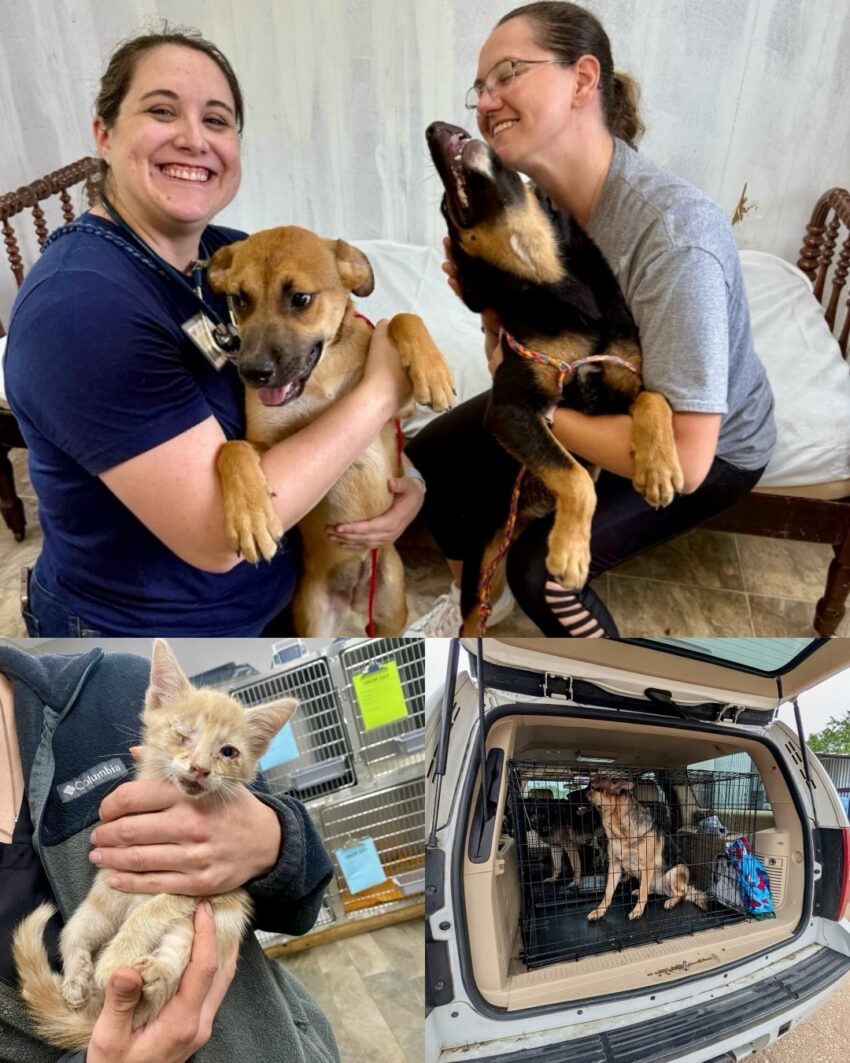The floods came with a ferocity that left nothing untouched. Entire neighborhoods were submerged under murky, churning waters. Families were torn apart, homes swept away, and lives forever altered. Over a hundred people lost their lives, while thousands more were displaced, left to wander streets that were once their backyards. Streets became rivers, and familiar landmarks disappeared beneath the relentless flow. The heartbreak was profound, rippling through the region and leaving a trail of grief that seemed impossible to mend.
Yet, even in the midst of such overwhelming devastation, small sparks of hope began to emerge.
While human lives were the first priority, there was another urgent need — the countless animals left behind in the chaos. Pets, livestock, and wildlife alike had been caught in the storm’s fury. Dogs and cats were stranded on rooftops, frightened and shivering. Chickens clung to fences, livestock were trapped in pastures turned into lakes, and wild animals struggled to navigate a suddenly treacherous environment. Their plight was often invisible, yet just as desperate as that of the humans around them.

Organizations like Austin Pets Alive! and Kerrville Pets Alive! sprang into action immediately. Volunteers worked tirelessly, navigating flooded streets, unstable debris, and strong currents, all to reach the animals in need. These rescuers faced danger and exhaustion head-on, driven by nothing more than compassion and the determination to save lives. Day after day, night after night, they provided care — food, water, medical attention, and comfort — for both the animals and the families devastated by the storm. Their work was more than a rescue; it was a lifeline in the midst of chaos.
Among the countless stories of survival was that of Daisy, a golden retriever who had been swept away by the floodwaters. Her family had managed to escape, but their hearts were heavy with worry. For days, they feared the worst, imagining her lost forever to the torrent. Volunteers eventually located Daisy, weak, muddy, and trembling, clinging desperately to the trunk of a tree as the waters swirled around her. When she was finally reunited with her family, tears flowed freely. It was a moment that symbolized hope — delicate, battered, yet unbroken. Daisy’s reunion with her family became more than a story of rescue; it was a symbol of resilience, love, and the quiet victories that emerge in the wake of disaster.

Stories like Daisy’s were repeated hundreds of times over. Dogs, cats, birds, and even larger animals found themselves saved by the brave volunteers who risked everything to reach them. Each rescue was a small triumph, a reminder that empathy and courage can shine even in the darkest circumstances. Volunteers worked with meticulous care, often improvising solutions to save lives, demonstrating that determination coupled with kindness could overcome nearly any obstacle.
The floods left scars — physical, emotional, and communal. Homes needed rebuilding, communities needed mending, and both humans and animals required care and support to heal. Yet amidst this recovery, one truth remained undeniable: compassion endures. It endures in the hands of volunteers, in the generosity of neighbors, and in the resilience of those who refuse to give up on others. People helping people, humans saving animals, communities coming together — this is what ensures survival, and what allows hope to flourish even when the waters rise.

In the face of disaster, the story of the floods is not only about destruction. It is about courage and the extraordinary lengths to which people will go to protect life. It is about the quiet acts of bravery that may never make headlines but change lives profoundly. Daisy, and every animal saved during that time, reminds us that hope can survive even the most devastating storms.
Today, many of the rescued animals live in safe homes or sanctuaries, loved and cared for, their trust slowly restored. Their stories are carried forward, inspiring others to act when danger threatens life. These moments — fleeting yet profound — illustrate that love and empathy can rise higher than the floodwaters. They teach that community is not merely a physical space but a network of care, courage, and commitment that binds us together in times of crisis.
